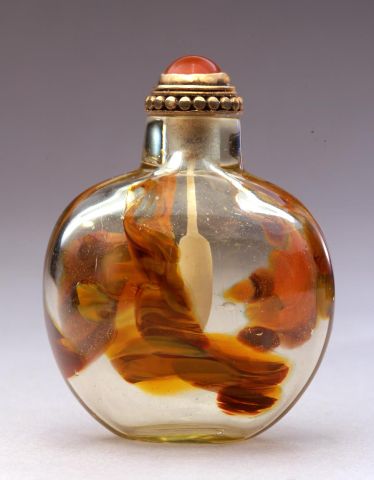
Bottle ID: 00059
CLEAR, LEADED W/SWIRLING MULTI-COLORED SPLASHES
Date: 1750-1800
Height: 51 mm
Glass, of rounded bulbous form, with straightened sides and a flat base, the transparent layers of glass with swirling splashes of brown, orange and yellow sandwiched between them.
Attributed to Beijing.
Similar Examples:
Hall, Robert. Chinese Snuff Bottles IV, p. 94, no. 93.
Provenance:
Clare Lawrence Ltd.
Richard A. Bourne, Co. Ltd., December 14, 1988, lot 71
Mrs. J. Gerald Mayer
Exhibited:
Annual Convention ICSBS Toronto, October 2007
Glass snuff bottles of the eighteenth century often have a weight which seems disproportionate to its thickness. This feature, seen as appealing, is caused by the amount of lead present in the lead-barium mix of the glass. Barium oxide is associated with the lead ores in China and even early Chinese glass beads from the fifth to the third centuries BC contained barium oxide. Until the nineteenth century, Western glass had only a trace of barium oxide. It is clear that the Palace glasshouse recycled glass in the eighteenth century from objects that were faulty, as the Palace Archives from the Qianlong period include the instructions to 'melt [glass] down for future use'. The Crane bottle is a fine example of weighted glass. Despite a temptation to cite it as an imitation of tortoiseshell, it is an appealing notion that if half filled with brown snuff the swirling colors in the clear glass would give the appearance of fragrant incense rising up through the bottle.
< Back to full list
 English
English 中文
中文